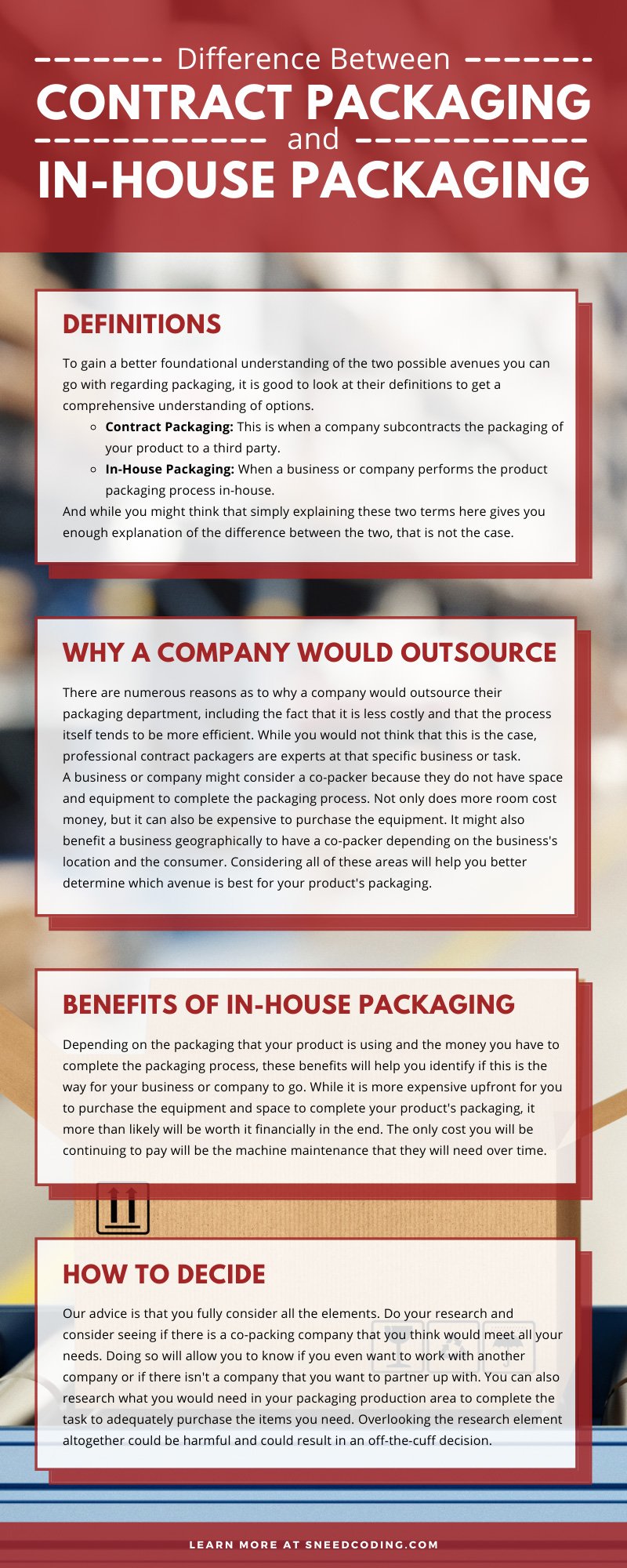
Every business venture is different, so finding the best packaging option for your needs is necessary. Whether you are starting this new venture or are looking for ways to improve your company, you should look into your packaging department. Doing so will allow you to see if the system you have is working or what avenue you want to go down regarding packaging. For a look at the difference between contract packaging and in-house packaging, continue reading. All the information you could want on this topic is right here!
Definitions
To gain a better foundational understanding of the two possible avenues you can go with regarding packaging, it is good to look at their definitions to get a comprehensive understanding of options.
- Contract Packaging: This is when a company subcontracts the packaging of your product to a third party.
- In-House Packaging: When a business or company performs the product packaging process in-house.
And while you might think that simply explaining these two terms here gives you enough explanation of the difference between the two, that is not the case. Continue reading the material we share in this article to see the many differences.
Why a Company Would Outsource
There are numerous reasons as to why a company would outsource their packaging department, including the fact that it is less costly and that the process itself tends to be more efficient. While you would not think that this is the case, professional contract packagers are experts at that specific business or task.
A business or company might consider a co-packer because they do not have space and equipment to complete the packaging process. Not only does more room cost money, but it can also be expensive to purchase the equipment. It might also benefit a business geographically to have a co-packer depending on the business's location and the consumer. Considering all of these areas will help you better determine which avenue is best for your product's packaging.
Benefits of In-House Packaging
Depending on the packaging that your product is using and the money you have to complete the packaging process, these benefits will help you identify if this is the way for your business or company to go. While it is more expensive upfront for you to purchase the equipment and space to complete your product's packaging, it more than likely will be worth it financially in the end. The only cost you will be continuing to pay will be the machine maintenance that they will need over time.
Many times people also go with in-house packaging because the need is not there. If you don't have to outsource it, don't. It is also how businesses tend to go if they are not financially prepared or organized enough to work with another company to complete the packaging process. Going this route will also allow you to manage and oversee the entire process to the fullest. If you have the knowledge and expertise to manage the packaging process, that is a bonus as well!
How To Decide
Truthfully, the answer is up to you and it greatly depends on where your business is currently at. If your business is going global and you have the finances and ability to outsource the packaging element, that might be the route for you. Or, if you have a little bit of money that you can spend upfront and want the ability to have the hands-on experience of overseeing your packaging, it might be the right call to keep it in-house. And if you have the space and the only thing that you need to purchase is the equipment, it might really be the way for you to go.
Our advice is that you fully consider all the elements. Do your research and consider seeing if there is a co-packing company that you think would meet all your needs. Doing so will allow you to know if you even want to work with another company or if there isn't a company that you want to partner up with. You can also research what you would need in your packaging production area to complete the task to adequately purchase the items you need. Overlooking the research element altogether could be harmful and could result in an off-the-cuff decision.
A Few Last-Minute Things To Keep In Mind
Your business is unique, so keep that uniqueness in the back of your mind when making this decision. By keeping this element in the back of your head, you can complete the decision for your company. This is important because your packaging is the first thing that individuals see when purchasing your product, so you want to make sure that this branding opportunity is a good one. You want it to look nice and properly represent your brand. Don't just decide on one or the other because you feel like you have to; we promise that the right one is out there for you!
We hope that this information covering the difference between contract packaging and in-house packagingsheds some light on this topic for you. Now, after reading this information, you hopefully have more clarity when it comes to deciding the best avenue for your business.
Here at Sneed Coding Inc., we want to do our part to help you #Keepcodingsimple for your business if you decide to go with in-house packaging. As stated above, with in-house packaging, you will need to have the equipment and space to package your products efficiently and successfully. With our case coding printers and other thermal inkjet printer options, we can help you find the equipment you need. Check out all of our inventory online today to see if any of the equipment pieces are right for you and your packaging needs. If you have any questions, feel free to give us a call and speak to one of our professionals. We want to do our part in helping you create the best packaging for your product!



